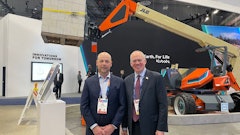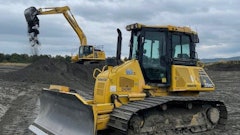
Pinnacle Development Group's Brad Humphrey, known for his The Contractor's Best Friend podcasts and consulting work in the construction industry, offers insights into how to identify potential leaders and how to train them once you have found them.
Allan Heydorn: Hello owners and top level managers, and welcome to the Ignite Construction Summit podcast. I’m Allan Heydorn, editor of Pavement Maintenance and Reconstruction and conference manager of the new Ignite Construction Summit which will be held December 12 and 13 in Las Vegas.
With me is Brad Humphrey, founder and president of Pinnacle Development Group, a consulting firm that has built its reputation by developing leaders and facilitating strategic growth. Known for his “Contractors Best Friend” podcast, Brad is a high energy presenter who’s in great demand internationally, so we’re lucky he’s in the state and had a window where we could invite him to Ignite. Thanks for taking the time to talk with me today, Brad, I appreciate it.
Brad Humphrey: Thank you, Allan. It’s great to be with you. I’m looking forward to what we can do to help the contractors.
Heydorn: That’s great. Listen, you’re kicking off the second day of the Ignite Summit with a topic that’s near, dear and, some might even say, feared among owners of upper level management of construction companies — and that’s leadership. So why is this such a challenge for companies? And if you can explain, how come so many companies make such poor decisions when selecting their leaders?
Humphrey: Wow. Well, there’s a mouthful. Let’s take the first part of that question first. I think a lot of the nervousness that I’ve observed with contractors over the last few years is just we’ve seen an incredible number of individuals who are veterans in the industry retiring. That includes owners of their own companies. They’re in the process of retiring — more of them are in the next three or four years. And they might have some limitations — they might have a son, son-in-law, daughter or daughter-in-law that might be taking over the business. And some, like the smaller businesses, don’t.
So they’re a little nervous there. they might have a group of good people, but they don’t have anyone to take over ownership. The other thing is that we’re losing a lot of our senior craftspeople and our foreman. And when these guys and gals leave, it seems like they’re leaving bigger holes than they’ve ever left.
But this country is so desperate for leadership that I think one of the problems contractors get into is sometimes they either, a) are not patient enough to really look for a leader; and therefore they might take with their second pick and promote someone who is not quite there yet or may not be really capable of those skills. But they do it anyway because they’re available, and then they live with the consequences.
But that’s a key component — lack of preparation. And I know that in most construction companies, they’ve done a horrible job of succession planning, and that’s obviously a pretty operative term these days. In fact, even on our website and through phone calls, email we get into Pinnacle, a lot of contractors are calling us now saying that they have so and so retiring, we need to backfill. So that’s a big deal for a lot of companies today.
Heydorn: So they’re just trying to fill a void. They know they have to have a leader so they take who’s available whether that person has the right skills or is even interested in the job, is that right?
Humphrey: That’s exactly right, In fact, I’ve seen a lot of what I call “reluctant leaders.” There are a lot of good people out there who really don’t want to be the leader, so they’re very reluctant to volunteer. And even when you ask them to take on a role, they’re still reluctant. I’m not saying these people can’t work out as leaders. Sometimes that’s a sense of humility which is often very good.
But if you’ve got an individual who’s just not motivated or built for that leadership role, to put them in that position you’re really kind of putting a square peg into a round hole; and that causes problems as well.
Heydorn: But that's where, for example, the two books that you have — “The Champion Leadership” and “Coaching the Emerging Leader,”— that’s where those books and those workshops would come into play. When you select someone who may not be ready for leadership and coach them through the process.
Humphrey: That’s exactly right. In fact, the one book, “Coaching the Emerging Leader,” was actually developed years ago. I actually got challenged by a couple of large contractors that asked if we could coach some of their “up and coming.”
So I began with a series of using articles and cutaway seminars I’ve led; and then after a year or two of doing that I thought, “I know how to do this, and I know what these people need.” So I put together what turned out to be the “Coaching the Emerging Leader” book.
Well, when I got that one done I had people who I had personally taken through the development to help them become a better foreman, a better superintendent, project manager or even a better owner.
When I got done with that, companies were saying that it was awesome and asking if I had something else to take people through to keep the growth going. That developed into the second, “The Champion Leadership” book you know about. And I tried to address 10 additional topics in that book that were not addressed in the first book to give a more well-rounded [lesson].
And we got into the higher level stuff of strategic thinking, running meetings, developing respect amongst your peers and that kind of stuff. So we really do know how to train. There’s an old saying that leaders are not born, they’re made. And I do think there are people who have a propensity towards leadership, maybe because of their profile, maybe because of their natural desire to help people. I think that helps.
But there are a lot of people who are good talkers or very empathetic who aren’t good leaders; they get taken advantage of. And I think I wrote those books to help individuals who may not see leadership inside themselves but others may see the potential.
But as a contractor or owner we don’t really know how to develop people in that way. We can teach people to pour concrete, or lay asphalt, or roll out and take measurements and do takeoff, but as far as the people side to that, that’s where I find most contractors are a little bit limited on. They know it instinctively, but to teach it and coach it is two different things. That’s why I wrote those books, and I do think they help people develop.
Heydorn: You’ve been doing this for a long time, and do you think that finding leaders is more difficult than it’s been in the past or do you think there’s just a greater need for leaders now? Like the example you used before, the baby boomers leaving the industry and there’s just more openings for them.
Humphrey: Well, no, I think it is harder today in a lot of ways, for a lot of reasons. There are a lot of talented people leaving the industry. You’ve got a lot of baby boomers retiring, a lot of millennials coming in, and then that next generation. And so I do think it’s a little more difficult today. And on top of that, I think the latest statistic I’ve read nationally is that we’ve got 7 million jobs opening up in the country total, and we’ve only got 2 or 3 million people total that are available to work.
So this is an interesting time, not only in our industry but a very interesting time in our country where it’s really an employee driven market. And that’s another problem that is presented to contractors, Allan, is that they may hire a foreman’s role or even as a laborer, and if they don’t like what they see or feel in the first couple weeks, they’re gone. And they can get hired tomorrow. That’s how quickly they’re getting hired again. And that is threatening.
I wrote a book years ago, it’s on Amazon on the seven steps of employee retention and that’s the 90-day plan. I think you are foolish, as an owner or a contractor, if you don’t have the first 90 days, and that’s just the first 12 weeks, mapped out. And maybe not hour by hour but what are the themes of what you want people to learn.
We’re going to be talking about this in my conference in December — what do you want them to know? They’re not going to know everything in 90 days, but you could expose them to enough information that you’re going to have a better feel of where they’re at; and they’re going to have a better feel on what you’re about.
Heydorn: So when a business owner is looking to fill a leadership role, do you think that it’s important that the leader they put in place has the skills of the people he’s supervising, or can they come from a different area and not have those skills?
Humphrey: Well, I think that that’s two different questions, but one is, A) I do think that the owners and contractors need to identify what they want in this job. And not just skills but something called competency; and that’s something I teach, and I call it competency based interviewing.
And that’s interviewing, not with “what if” questions, but “here's what we need; what examples do you have that you can do this or you’ve done it successfully?” So I do think you’re looking at two things there.
The second part is, you may still hire people you don’t know everything about. You’re going to hire people with a lot more that you don’t know, and that’s why I put that 90-day plan chapter in there, Allan, whatever you plan for, develop it. I find that most contractors have a job description, maybe, but they really don’t know what they want in that job. And I don't just mean technical skills. Who’s that job going to report to? Who’s going to report to them? How do they get along with their peers? What kind of reporting communication is needed?
They don’t talk about those things, much less write them down. So I think the best advice I can give any contractors — if you’re looking to hire, whether it’s a leader, a mid-level person or even a laborer — develop at least one sheet that says these are the skills we’re looking for and the competencies we’re looking for. Competencies could include things like team building, emphasis on safety, team oriented, communication driven. Those are competencies, not just skills. So I think that would be where I would start for an owner.
Heydorn: So that’s really different than a job description, or it’s in addition to a job description.
Humphrey: It’s in addition to a job description. And the sad thing is that some contractors haven’t even developed their own job description. I mean, you can Google anything today. So they probably have printed off some job descriptions from the Internet, which I don’t think is all together bad. You don’t have to recreate the wheel, but when I say competencies I’m not talking about just a list of skills.
What are the things that make the job successful, not just skill wise, but what is it that makes the job successful? Like I said, strategy is a part of that, communication is a part of that, negotiation skills is a competency. All of those are competencies.
Heydorn: Well, the title of your session at Ignite is “How to Identify Future Leaders and What to Do When You Find Them.” And to me that sounds like a how-to approach that's designed to give owners and managers tools on how to put the skills to use.
Humphrey: Right. That’s exactly right. You’ve known me for a long time; I’m sort of a how-to guy; don’t write much theory. And so much of what I’m going to talk about, especially on where the folks are at and where to find them, both internally in the company and externally.
You know, I have a funny story, it’s called the Wendy’s win. And I’ll give you a quick example. I had a contractor years ago that had to drop a bid off, but before they dropped the bid off, it was around lunchtime, so they went to Wendy’s. To make a long story short, the Wendy’s drive through speaker system broke. And so the manager of the store, who’s normally in charge of that, he completely lost it. He got upset, lost his temper and evidently he said some not nice things to the employees.
Basically he went back to his office and closed the door. The contractor friend that was in there was done with lunch, but he told me he had to stay there because he saw something really cool happening. One of the employees, we found out later it was a 19 or 20-year-old kid, started taking charge. He basically went around, calmed the employees down, apologized to people waiting in line, and he heard him tell the rest of the workers that he’d take the sign and go out there and take orders from the cars.
To make a long story short, once it was all over and the pressure was off, the manager came back out. But what was funny was, before this contractor left Wendy's to go on to his appointment, he got the attention of the young guy who did all that cool stuff and brought him over to the table and asked how he did that.
The young guy asked what he was talking about, and he told him he saw what he did. He calmed the thing down, took the orders and he really brought the place back to order after his boss left him. The young guy told him he really didn’t know, just that he knows they have to help the customers, sort of thing.
And so the contractor looked him right in the eye and asked him how much they pay him here, and the young guy told him. So the contractor told him he’d pay him five dollars more an hour if he comes to work for him. And the young guy said he didn’t know anything about construction.
The contractor said that he could teach him construction, but he couldn’t teach him that kind of stuff. What he’s referring to is competencies. He saw something in that young man that he might not have even seen in construction.
So one of the things I’m going to try to help people with at that conference in December, Allan, is that we have to get out of the traditional areas that we go looking for replacements for our people. We may find potential workers, much less leaders in other companies and industries, and we just have to be open to that.
Heydorn: Yeah, I’m sure there are a lot of contractors out there who would like to run across that young 19-year-old kid one place or another, whether that’s inside their own companies or at a Wendy’s.
Humphrey: Right, exactly. It’s so funny, but half the time I’ve shared that story at difference conferences over the last five to 10 years because this happened 10 years ago, but everytime I share that story, you’ll see people writing notes in their books to go to Wendy’s as soon as the conference is over.
Heydorn: Start eating lunch at Wendy’s, right?
Humphrey: Exactly, right. But my point is that construction has done a horrible job at publicizing the real benefits. Did you know that statistically the average earner in construction earns more money over the course, even in their early years, more than any other uneducated job can provide? It’s one of the best paying jobs in the industry, but it’s one of the best kept secrets, too.
Heydorn: Well, listen, I enjoyed talking to you Brad, but before we go, I know you have a two minute drill video series on your website. How’s that doing? It seems like that’s a training tool that fits perfectly in an industry like construction that’s always on the go.
Humphrey: Well we’ve actually upgraded. it’s actually on an app. We have an educational app, and all you have to do is go to the App store, and type in “Pinnacle Development Group,” and you can download the app. It’s totally free. We actually trademarked it; that was pretty exciting last year. We got the government trademark for it.
But it’s called the “Two Minute Drill” video series, and it’s literally a series of me doing talks on a topic for only two minutes. And we actually have a clock, so you can take my word for that. But the last count from my producers on that is that we have over 5,000 people who have downloaded the app.
We have a really cool following that’s coming along. I get emails from companies I’ve never even heard of that they use the app once a week in their meetings with their foreman or their crews. And that’s really been a blessing for us because it’s allowed me to get more of our messages about leadership. And it’s actually cool, Allan, because it’s divided into five segments.
There is a section of probably about 25 to 30 videos that are just for owners and senior leaders. We have some for front line field leaders; we have some for sales and marketing people. We have some that are just a general category with how to set goals, that kind of stuff. And we’re really proud of this. We have about 20 videos for just the front line employee; you know, there’s nothing for laborers out there. So it’s a good opportunity, a great resource for people. And like I say in the video, everybody’s got two minutes.
Heydorn: Well, like I said, it’s a perfect fit for an industry as busy as this one. Well, listen, I enjoyed talking to you. I appreciate the time, and I’m sure that some of the listeners of this podcast are already putting your Ignite session into their Outlook calendars.
But to learn more about Brad including his books, podcasts and two minute drill you can visit www.pinnacledg.com.
This has been Allan Heydorn for the Ignite Construction Summit. for a complete description of Brad’s session as well as other Ignite details visit www.igniteconstructionsummit.com. Thank you, Brad.
Humphrey: Thank you, Allan.




















